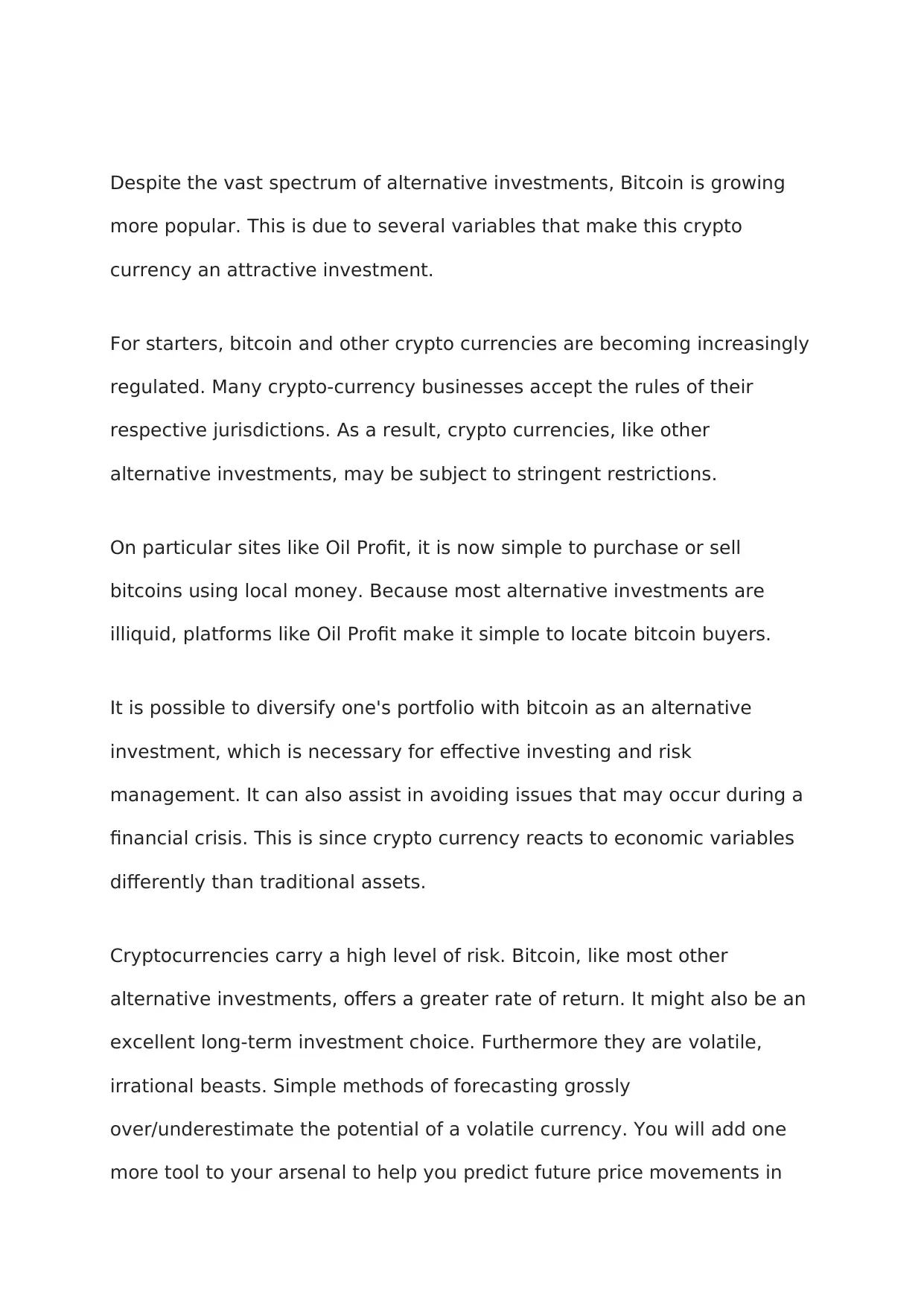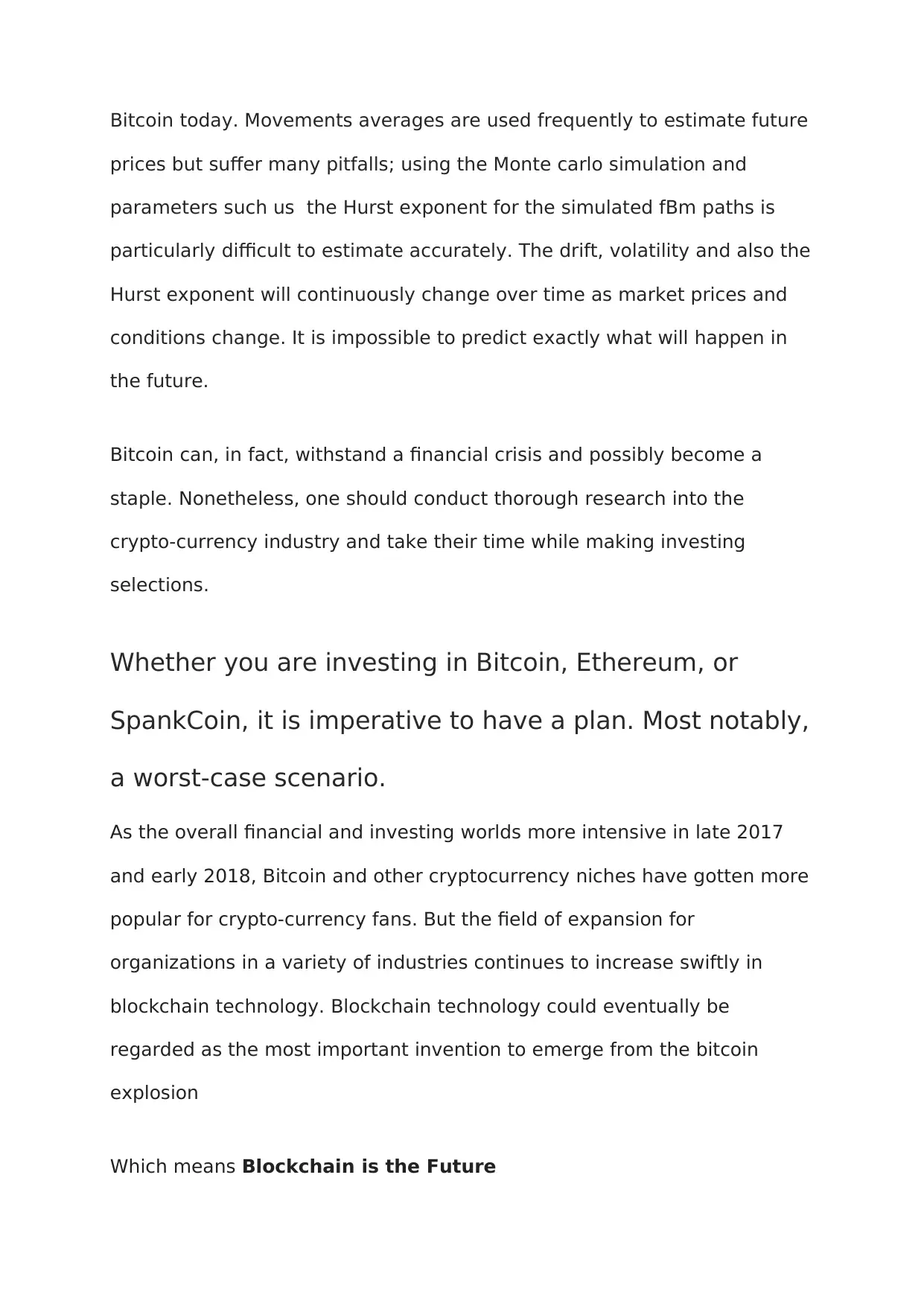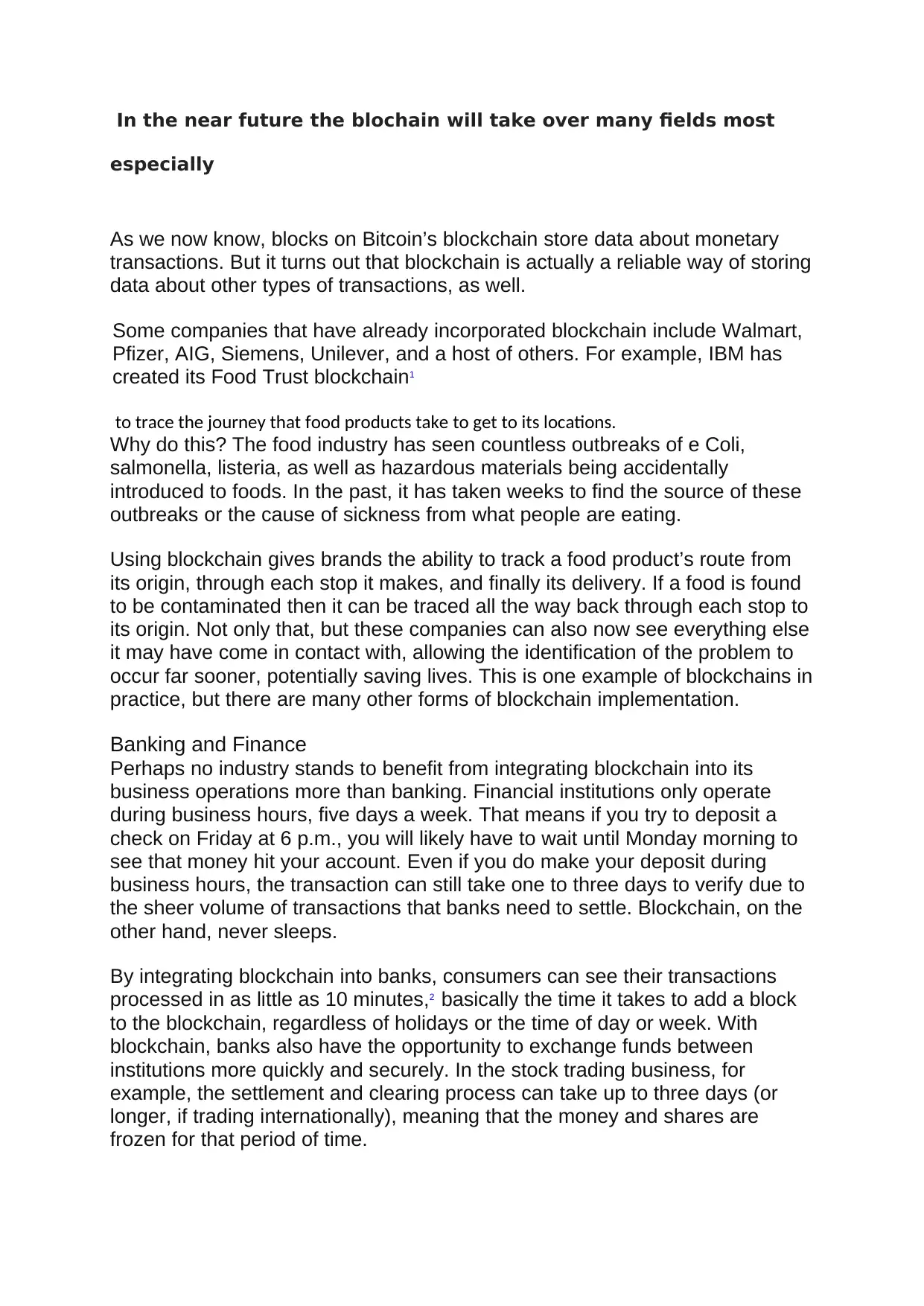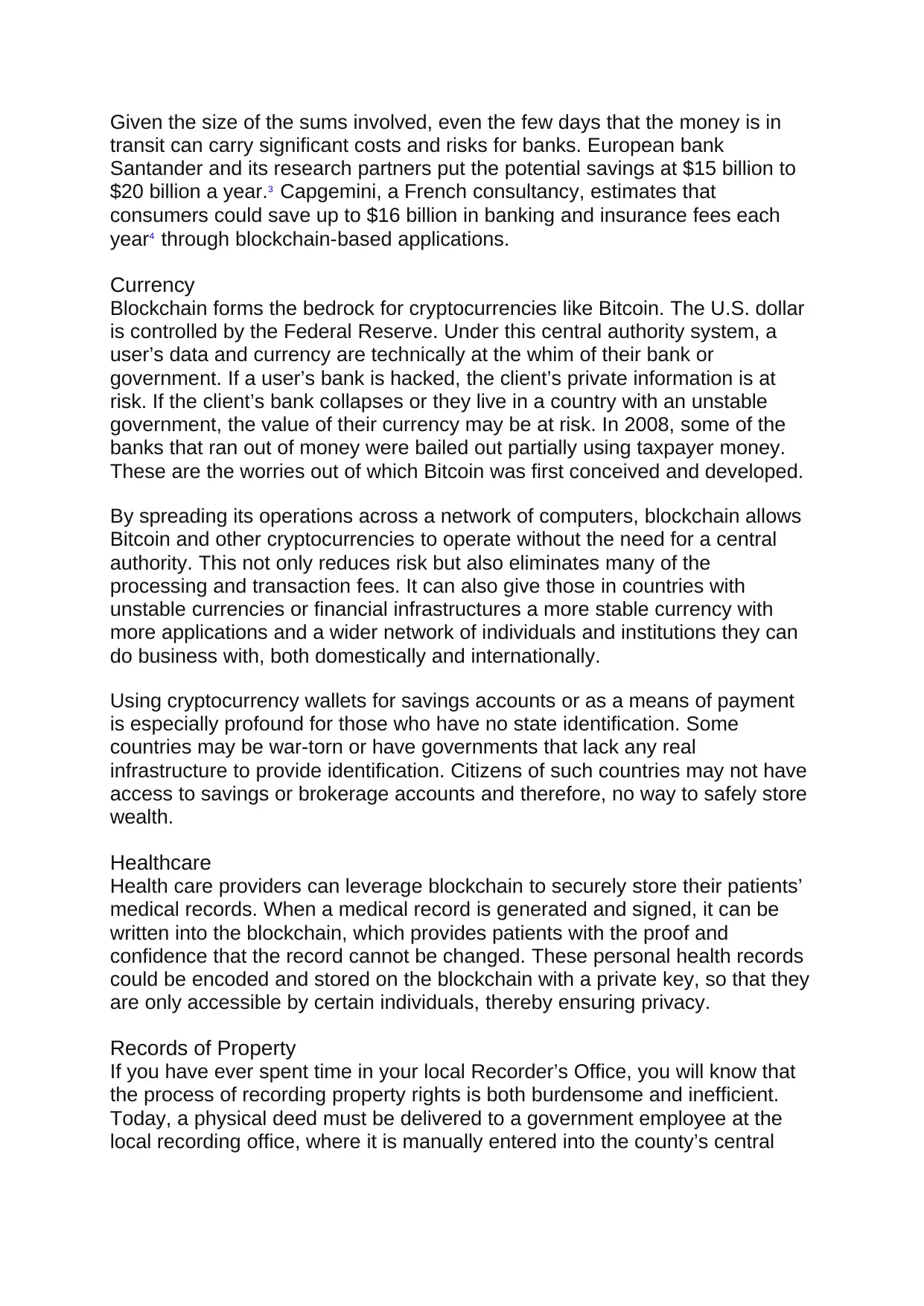Bitcoin, Blockchain, and the Future of Finance and Technology
VerifiedAdded on 2022/01/15
|5
|1938
|39
Report
AI Summary
This report provides a comprehensive overview of Bitcoin and blockchain technology, highlighting their growing popularity as alternative investments. It delves into the increasing regulation of cryptocurrencies and the ease of buying and selling Bitcoin through platforms like Oil Profit. The report explores Bitcoin's role in portfolio diversification, risk management, and its potential to withstand financial crises. Furthermore, it examines the transformative impact of blockchain technology across various sectors, including banking and finance, healthcare, supply chains, and voting systems. The report discusses real-world applications, such as IBM's Food Trust blockchain, and analyzes the benefits of blockchain integration in terms of security, efficiency, and transparency, while also discussing the potential of smart contracts and their impact on various industries.

Despite the vast spectrum of alternative investments, Bitcoin is growing
more popular. This is due to several variables that make this crypto
currency an attractive investment.
For starters, bitcoin and other crypto currencies are becoming increasingly
regulated. Many crypto-currency businesses accept the rules of their
respective jurisdictions. As a result, crypto currencies, like other
alternative investments, may be subject to stringent restrictions.
On particular sites like Oil Profit, it is now simple to purchase or sell
bitcoins using local money. Because most alternative investments are
illiquid, platforms like Oil Profit make it simple to locate bitcoin buyers.
It is possible to diversify one's portfolio with bitcoin as an alternative
investment, which is necessary for effective investing and risk
management. It can also assist in avoiding issues that may occur during a
financial crisis. This is since crypto currency reacts to economic variables
differently than traditional assets.
Cryptocurrencies carry a high level of risk. Bitcoin, like most other
alternative investments, offers a greater rate of return. It might also be an
excellent long-term investment choice. Furthermore they are volatile,
irrational beasts. Simple methods of forecasting grossly
over/underestimate the potential of a volatile currency. You will add one
more tool to your arsenal to help you predict future price movements in
more popular. This is due to several variables that make this crypto
currency an attractive investment.
For starters, bitcoin and other crypto currencies are becoming increasingly
regulated. Many crypto-currency businesses accept the rules of their
respective jurisdictions. As a result, crypto currencies, like other
alternative investments, may be subject to stringent restrictions.
On particular sites like Oil Profit, it is now simple to purchase or sell
bitcoins using local money. Because most alternative investments are
illiquid, platforms like Oil Profit make it simple to locate bitcoin buyers.
It is possible to diversify one's portfolio with bitcoin as an alternative
investment, which is necessary for effective investing and risk
management. It can also assist in avoiding issues that may occur during a
financial crisis. This is since crypto currency reacts to economic variables
differently than traditional assets.
Cryptocurrencies carry a high level of risk. Bitcoin, like most other
alternative investments, offers a greater rate of return. It might also be an
excellent long-term investment choice. Furthermore they are volatile,
irrational beasts. Simple methods of forecasting grossly
over/underestimate the potential of a volatile currency. You will add one
more tool to your arsenal to help you predict future price movements in
Paraphrase This Document
Need a fresh take? Get an instant paraphrase of this document with our AI Paraphraser

Bitcoin today. Movements averages are used frequently to estimate future
prices but suffer many pitfalls; using the Monte carlo simulation and
parameters such us the Hurst exponent for the simulated fBm paths is
particularly difficult to estimate accurately. The drift, volatility and also the
Hurst exponent will continuously change over time as market prices and
conditions change. It is impossible to predict exactly what will happen in
the future.
Bitcoin can, in fact, withstand a financial crisis and possibly become a
staple. Nonetheless, one should conduct thorough research into the
crypto-currency industry and take their time while making investing
selections.
Whether you are investing in Bitcoin, Ethereum, or
SpankCoin, it is imperative to have a plan. Most notably,
a worst-case scenario.
As the overall financial and investing worlds more intensive in late 2017
and early 2018, Bitcoin and other cryptocurrency niches have gotten more
popular for crypto-currency fans. But the field of expansion for
organizations in a variety of industries continues to increase swiftly in
blockchain technology. Blockchain technology could eventually be
regarded as the most important invention to emerge from the bitcoin
explosion
Which means Blockchain is the Future
prices but suffer many pitfalls; using the Monte carlo simulation and
parameters such us the Hurst exponent for the simulated fBm paths is
particularly difficult to estimate accurately. The drift, volatility and also the
Hurst exponent will continuously change over time as market prices and
conditions change. It is impossible to predict exactly what will happen in
the future.
Bitcoin can, in fact, withstand a financial crisis and possibly become a
staple. Nonetheless, one should conduct thorough research into the
crypto-currency industry and take their time while making investing
selections.
Whether you are investing in Bitcoin, Ethereum, or
SpankCoin, it is imperative to have a plan. Most notably,
a worst-case scenario.
As the overall financial and investing worlds more intensive in late 2017
and early 2018, Bitcoin and other cryptocurrency niches have gotten more
popular for crypto-currency fans. But the field of expansion for
organizations in a variety of industries continues to increase swiftly in
blockchain technology. Blockchain technology could eventually be
regarded as the most important invention to emerge from the bitcoin
explosion
Which means Blockchain is the Future

In the near future the blochain will take over many fields most
especially
As we now know, blocks on Bitcoin’s blockchain store data about monetary
transactions. But it turns out that blockchain is actually a reliable way of storing
data about other types of transactions, as well.
Some companies that have already incorporated blockchain include Walmart,
Pfizer, AIG, Siemens, Unilever, and a host of others. For example, IBM has
created its Food Trust blockchain1
to trace the journey that food products take to get to its locations.
Why do this? The food industry has seen countless outbreaks of e Coli,
salmonella, listeria, as well as hazardous materials being accidentally
introduced to foods. In the past, it has taken weeks to find the source of these
outbreaks or the cause of sickness from what people are eating.
Using blockchain gives brands the ability to track a food product’s route from
its origin, through each stop it makes, and finally its delivery. If a food is found
to be contaminated then it can be traced all the way back through each stop to
its origin. Not only that, but these companies can also now see everything else
it may have come in contact with, allowing the identification of the problem to
occur far sooner, potentially saving lives. This is one example of blockchains in
practice, but there are many other forms of blockchain implementation.
Banking and Finance
Perhaps no industry stands to benefit from integrating blockchain into its
business operations more than banking. Financial institutions only operate
during business hours, five days a week. That means if you try to deposit a
check on Friday at 6 p.m., you will likely have to wait until Monday morning to
see that money hit your account. Even if you do make your deposit during
business hours, the transaction can still take one to three days to verify due to
the sheer volume of transactions that banks need to settle. Blockchain, on the
other hand, never sleeps.
By integrating blockchain into banks, consumers can see their transactions
processed in as little as 10 minutes,2 basically the time it takes to add a block
to the blockchain, regardless of holidays or the time of day or week. With
blockchain, banks also have the opportunity to exchange funds between
institutions more quickly and securely. In the stock trading business, for
example, the settlement and clearing process can take up to three days (or
longer, if trading internationally), meaning that the money and shares are
frozen for that period of time.
especially
As we now know, blocks on Bitcoin’s blockchain store data about monetary
transactions. But it turns out that blockchain is actually a reliable way of storing
data about other types of transactions, as well.
Some companies that have already incorporated blockchain include Walmart,
Pfizer, AIG, Siemens, Unilever, and a host of others. For example, IBM has
created its Food Trust blockchain1
to trace the journey that food products take to get to its locations.
Why do this? The food industry has seen countless outbreaks of e Coli,
salmonella, listeria, as well as hazardous materials being accidentally
introduced to foods. In the past, it has taken weeks to find the source of these
outbreaks or the cause of sickness from what people are eating.
Using blockchain gives brands the ability to track a food product’s route from
its origin, through each stop it makes, and finally its delivery. If a food is found
to be contaminated then it can be traced all the way back through each stop to
its origin. Not only that, but these companies can also now see everything else
it may have come in contact with, allowing the identification of the problem to
occur far sooner, potentially saving lives. This is one example of blockchains in
practice, but there are many other forms of blockchain implementation.
Banking and Finance
Perhaps no industry stands to benefit from integrating blockchain into its
business operations more than banking. Financial institutions only operate
during business hours, five days a week. That means if you try to deposit a
check on Friday at 6 p.m., you will likely have to wait until Monday morning to
see that money hit your account. Even if you do make your deposit during
business hours, the transaction can still take one to three days to verify due to
the sheer volume of transactions that banks need to settle. Blockchain, on the
other hand, never sleeps.
By integrating blockchain into banks, consumers can see their transactions
processed in as little as 10 minutes,2 basically the time it takes to add a block
to the blockchain, regardless of holidays or the time of day or week. With
blockchain, banks also have the opportunity to exchange funds between
institutions more quickly and securely. In the stock trading business, for
example, the settlement and clearing process can take up to three days (or
longer, if trading internationally), meaning that the money and shares are
frozen for that period of time.
⊘ This is a preview!⊘
Do you want full access?
Subscribe today to unlock all pages.

Trusted by 1+ million students worldwide

Given the size of the sums involved, even the few days that the money is in
transit can carry significant costs and risks for banks. European bank
Santander and its research partners put the potential savings at $15 billion to
$20 billion a year.3 Capgemini, a French consultancy, estimates that
consumers could save up to $16 billion in banking and insurance fees each
year4 through blockchain-based applications.
Currency
Blockchain forms the bedrock for cryptocurrencies like Bitcoin. The U.S. dollar
is controlled by the Federal Reserve. Under this central authority system, a
user’s data and currency are technically at the whim of their bank or
government. If a user’s bank is hacked, the client’s private information is at
risk. If the client’s bank collapses or they live in a country with an unstable
government, the value of their currency may be at risk. In 2008, some of the
banks that ran out of money were bailed out partially using taxpayer money.
These are the worries out of which Bitcoin was first conceived and developed.
By spreading its operations across a network of computers, blockchain allows
Bitcoin and other cryptocurrencies to operate without the need for a central
authority. This not only reduces risk but also eliminates many of the
processing and transaction fees. It can also give those in countries with
unstable currencies or financial infrastructures a more stable currency with
more applications and a wider network of individuals and institutions they can
do business with, both domestically and internationally.
Using cryptocurrency wallets for savings accounts or as a means of payment
is especially profound for those who have no state identification. Some
countries may be war-torn or have governments that lack any real
infrastructure to provide identification. Citizens of such countries may not have
access to savings or brokerage accounts and therefore, no way to safely store
wealth.
Healthcare
Health care providers can leverage blockchain to securely store their patients’
medical records. When a medical record is generated and signed, it can be
written into the blockchain, which provides patients with the proof and
confidence that the record cannot be changed. These personal health records
could be encoded and stored on the blockchain with a private key, so that they
are only accessible by certain individuals, thereby ensuring privacy.
Records of Property
If you have ever spent time in your local Recorder’s Office, you will know that
the process of recording property rights is both burdensome and inefficient.
Today, a physical deed must be delivered to a government employee at the
local recording office, where it is manually entered into the county’s central
transit can carry significant costs and risks for banks. European bank
Santander and its research partners put the potential savings at $15 billion to
$20 billion a year.3 Capgemini, a French consultancy, estimates that
consumers could save up to $16 billion in banking and insurance fees each
year4 through blockchain-based applications.
Currency
Blockchain forms the bedrock for cryptocurrencies like Bitcoin. The U.S. dollar
is controlled by the Federal Reserve. Under this central authority system, a
user’s data and currency are technically at the whim of their bank or
government. If a user’s bank is hacked, the client’s private information is at
risk. If the client’s bank collapses or they live in a country with an unstable
government, the value of their currency may be at risk. In 2008, some of the
banks that ran out of money were bailed out partially using taxpayer money.
These are the worries out of which Bitcoin was first conceived and developed.
By spreading its operations across a network of computers, blockchain allows
Bitcoin and other cryptocurrencies to operate without the need for a central
authority. This not only reduces risk but also eliminates many of the
processing and transaction fees. It can also give those in countries with
unstable currencies or financial infrastructures a more stable currency with
more applications and a wider network of individuals and institutions they can
do business with, both domestically and internationally.
Using cryptocurrency wallets for savings accounts or as a means of payment
is especially profound for those who have no state identification. Some
countries may be war-torn or have governments that lack any real
infrastructure to provide identification. Citizens of such countries may not have
access to savings or brokerage accounts and therefore, no way to safely store
wealth.
Healthcare
Health care providers can leverage blockchain to securely store their patients’
medical records. When a medical record is generated and signed, it can be
written into the blockchain, which provides patients with the proof and
confidence that the record cannot be changed. These personal health records
could be encoded and stored on the blockchain with a private key, so that they
are only accessible by certain individuals, thereby ensuring privacy.
Records of Property
If you have ever spent time in your local Recorder’s Office, you will know that
the process of recording property rights is both burdensome and inefficient.
Today, a physical deed must be delivered to a government employee at the
local recording office, where it is manually entered into the county’s central
Paraphrase This Document
Need a fresh take? Get an instant paraphrase of this document with our AI Paraphraser

database and public index. In the case of a property dispute, claims to the
property must be reconciled with the public index.
This process is not just costly and time-consuming—it is also riddled with
human error, where each inaccuracy makes tracking property ownership less
efficient. Blockchain has the potential to eliminate the need for scanning
documents and tracking down physical files in a local recording office. If
property ownership is stored and verified on the blockchain, owners can trust
that their deed is accurate and permanently recorded.
In war-torn countries or areas that have little to no government or financial
infrastructure, and certainly no “Recorder’s Office,” it can be nearly impossible
to prove ownership of a property. If a group of people living in such an area is
able to leverage blockchain, transparent and clear timelines of property
ownership could be established.
Smart Contracts
A smart contract is a computer code that can be built into the blockchain to
facilitate, verify, or negotiate a contract agreement. Smart contracts operate
under a set of conditions that users agree to. When those conditions are met,
the terms of the agreement are automatically carried out.
Say, for example, a potential tenant would like to lease an apartment using a
smart contract. The landlord agrees to give the tenant the door code to the
apartment as soon as the tenant pays the security deposit. Both the tenant
and the landlord would send their respective portions of the deal to the smart
contract, which would hold onto and automatically exchange the door code for
the security deposit on the date the lease begins. If the landlord doesn’t supply
the door code by the lease date, the smart contract refunds the security
deposit. This would eliminate the fees and processes typically associated with
the use of a notary, third-party mediator, or attornies.
Supply Chains
As in the IBM Food Trust example, suppliers can use blockchain to record the
origins of materials that they have purchased. This would allow companies to
verify the authenticity of their products, along with such common labels as
“Organic,” “Local,” and “Fair Trade.”
As reported by Forbes, the food industry is increasingly adopting the use of
blockchain to track the path and safety of food throughout the farm-to-user
journey.
Voting
As mentioned, blockchain could be used to facilitate a modern voting system.
Voting with blockchain carries the potential to eliminate election fraud and
boost voter turnout, as was tested in the November 2018 midterm elections in
West Virginia.Using blockchain in this way would make votes nearly
property must be reconciled with the public index.
This process is not just costly and time-consuming—it is also riddled with
human error, where each inaccuracy makes tracking property ownership less
efficient. Blockchain has the potential to eliminate the need for scanning
documents and tracking down physical files in a local recording office. If
property ownership is stored and verified on the blockchain, owners can trust
that their deed is accurate and permanently recorded.
In war-torn countries or areas that have little to no government or financial
infrastructure, and certainly no “Recorder’s Office,” it can be nearly impossible
to prove ownership of a property. If a group of people living in such an area is
able to leverage blockchain, transparent and clear timelines of property
ownership could be established.
Smart Contracts
A smart contract is a computer code that can be built into the blockchain to
facilitate, verify, or negotiate a contract agreement. Smart contracts operate
under a set of conditions that users agree to. When those conditions are met,
the terms of the agreement are automatically carried out.
Say, for example, a potential tenant would like to lease an apartment using a
smart contract. The landlord agrees to give the tenant the door code to the
apartment as soon as the tenant pays the security deposit. Both the tenant
and the landlord would send their respective portions of the deal to the smart
contract, which would hold onto and automatically exchange the door code for
the security deposit on the date the lease begins. If the landlord doesn’t supply
the door code by the lease date, the smart contract refunds the security
deposit. This would eliminate the fees and processes typically associated with
the use of a notary, third-party mediator, or attornies.
Supply Chains
As in the IBM Food Trust example, suppliers can use blockchain to record the
origins of materials that they have purchased. This would allow companies to
verify the authenticity of their products, along with such common labels as
“Organic,” “Local,” and “Fair Trade.”
As reported by Forbes, the food industry is increasingly adopting the use of
blockchain to track the path and safety of food throughout the farm-to-user
journey.
Voting
As mentioned, blockchain could be used to facilitate a modern voting system.
Voting with blockchain carries the potential to eliminate election fraud and
boost voter turnout, as was tested in the November 2018 midterm elections in
West Virginia.Using blockchain in this way would make votes nearly
1 out of 5
Your All-in-One AI-Powered Toolkit for Academic Success.
+13062052269
info@desklib.com
Available 24*7 on WhatsApp / Email
![[object Object]](/_next/static/media/star-bottom.7253800d.svg)
Unlock your academic potential
Copyright © 2020–2025 A2Z Services. All Rights Reserved. Developed and managed by ZUCOL.

